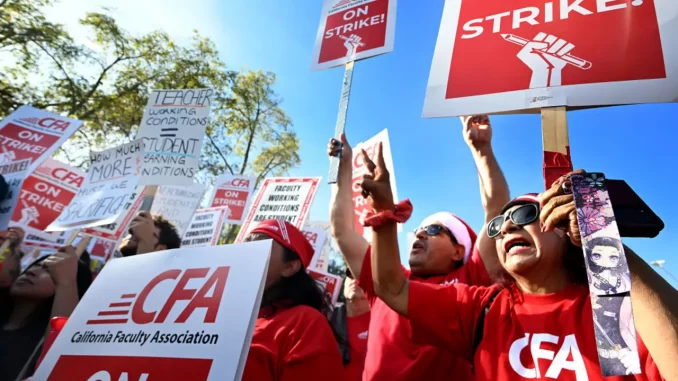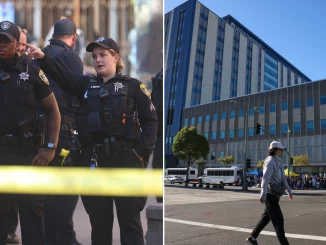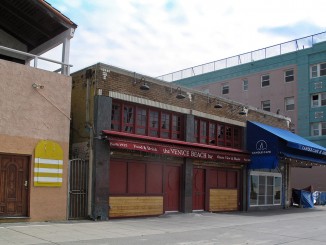
The California State University (CSU) system found itself in a clash with the California Faculty Association (CFA), representing a diverse body of 28,000 faculty employees, including tenure-track and lecturers, counselors, librarians, and coaches. On January 22, the CFA launched a statewide strike, targeting all 23 CSU campuses. This coincided with the start of the spring semester classes at Sacramento State, ensuring a significant disruption to regular academic activities. Notably, this marks the first time in the CSU system’s history that a statewide faculty strike has taken place since the faculty established their union in 1983.
This labor dispute has been an eight-month-long bargaining process between the CSU system and the CFA union. The two sides have faced multiple impasses, leading to mounting frustrations among faculty members. The CSU system currently has only 55 percent of full-time equivalent (FTE) faculty in tenure-track positions. In December, four campuses engaged in a limited and partial strike. After that strike action, rank-and-file members pushed for a strike that would shut down the entire state-wide system. The CFA claims that the CSU system has not been bargaining in good faith, an assertion the university system staunchly rejects. The dispute intensified when the union, with findings from an auditor, revealed substantial financial reserves within the CSU system—$8 billion in unrestricted reserves and $11 billion in investments—when workers are demanding an amount less than $400 million.
The CFU proposed a comprehensive set of demands: a 12 percent general wage increase for all members and an initiative to raise the salary floor for the lowest-paid lecturer faculty members, aiming to rectify structural inequities. This is the first time the union has negotiated salaries with a specific focus on reducing disparities between tenure-track and lecturer faculty. The CFA is also advocating for crucial workload protections, including class size caps and enforcing the federal counselor/student ratio of 1/1,500. Additionally, the union is pushing for “common good” demands or social justice demands: a full semester of parental leave, additional mental health counselors for students, and more manageable workloads for faculty.
On Friday, January 19, three days before the start of the strike, the Teamsters Local 2010 union, representing workers such as plumbers and electricians, came to a tentative agreement (TA) with the CSU system. The TA would be sent to the union members to vote and ratify the agreement, and so their planned participation in the strike was canceled. However, the CFA union, the union representing faculty workers, had still not reached an agreement with the University, and so went on strike alone.
In the build-up to the strike, the CSU administration attempted to pit students against the CFA faculty, encouraging students to report faculty members who canceled classes and services through an online form. CSU Long Beach students received an email on January 16 containing the form, and the administration had previously distributed it in December to students from campuses that had experienced strikes. In response, some students took to social media, and announced plans to “spam” the forms with incorrect or unrelated information as a form of protest, disrupting the university’s data collection and standing in solidarity with the faculty.
The CFA also stands in solidarity with the CSU students because the University plans to raise tuition in the Fall of 2024. With a staggering $1.5 billion funding gap, the burden of financial strain has been shifted onto the students through tuition hikes starting in fall 2024. This move was coupled with the revelation that the cost of management has increased by $215 million since 2019, while investment in critical areas like instruction, academic support, and maintenance has sharply decreased. This underscores the systemic issues at play.
The CFA strike has exposed the unjust allocation of resources within the CSU system. As faculty members advocate for fair compensation and improved working conditions, Chancellor Mildred Garcia receives close to $1 million in total compensation. Meanwhile, CSU campus presidents enjoyed a substantial 29 percent increase in their pay just last year. The stark contrast in financial decisions becomes even more apparent when considering the CSU system’s recent implementation of the first tuition increase in over a decade. As the Chancellor’s office alone spends $200 million annually, the disparity between the distribution of funds and the faculty’s demands for just compensation and improved working conditions further highlights the urgent need to reevaluate budget priorities.
The CFA embraced an ambitious bargaining agenda reflecting members’ needs. However, in a surprising turn of events, the CFA and the CSU came to a tentative agreement after a single strike day and the CFA officials announced the end of the strike. Some of the agreement highlights include a 5 percent general salary increase for all faculty members, retroactive to July 1, 2023, and an additional 5 percent increase scheduled for July 1, 2024. The agreement also involves raising the salary floor for the lowest-paid faculty. Paid parental leave is set to increase from 6 to 10 weeks. Now CFA members will vote on the agreement for ratification. If the members vote NO, then the CFA bargaining members will need to return to the negotiating table with the University, and CFA members workers may go back on strike.
Following the release of the tentative agreement, some CFA members have organized meetings and actions to show their dissatisfaction with the agreement that falls far short of their original demands. However, only the election results will be able to show whether the sentiment of dissatisfaction with the agreement is widely and deeply felt by the CFA membership across the 23 campuses.
The question is what CFA members are ready and willing to do. Will they accept this tentative agreement or do they want to go back to the bargaining table and go back on strike to try to win more of the demands they originally struck for?




